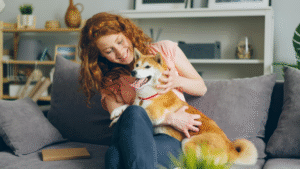Does your dog bark excessively at the mailman, neighbors, passing cars, or other dogs? It can be incredibly frustrating! Dogs bark naturally—it’s part of canine communication. However, there’s a fine line between a happy, alert dog and one who barks all the time.
The solution? Teaching your dog the “Quiet” command. This useful cue helps your dog learn when it’s appropriate to bark—and when it’s time to stay calm and silent. With patience, positive reinforcement, and consistency, you can train your dog to speak up or stay quiet on cue. Here are five simple steps to help you teach your dog “Quiet.”

Why You Should Teach Your Dog the “Quiet” Command
Chances are, you already know why your dog barks. Dogs bark for many reasons—to alert, express joy or frustration, get attention, relieve boredom, or simply because they’re naturally vocal. Some dogs bark more than others depending on their breed, age, and personality. For instance, young puppies often bark more than older, trained dogs.
Common Reasons Dogs Bark
-
Alert barking: To warn of an intruder, stranger, or unusual noise.
-
Attention-seeking barking: To demand food, playtime, petting, or attention.
-
Fear or anxiety barking: In response to a perceived threat such as a stranger, loud sound, or separation.
-
Boredom barking: When they’re under-stimulated physically or mentally.
-
Territorial barking: To defend their home or territory from perceived intruders.
Teaching your dog “Quiet” isn’t about silencing them completely. It’s about helping them understand when barking is appropriate (such as alerting or greeting) and when it’s time to stop. Dogs trained to respond to “Quiet” are calmer, less anxious, and more attuned to their surroundings.
Related: 10 Healthy Cat Treats They Will Come Running For
Step 1: Teach Your Dog the “Speak” Command First
Teaching “Quiet” is much easier if your dog already understands how to bark on command. Having two related cues—one for barking (“Speak”) and one for stopping (“Quiet”)—helps your dog clearly distinguish between the two behaviors.
How to Teach “Speak”
-
Find a stimulus that naturally makes your dog bark, such as:
-
The doorbell
-
Someone knocking
-
A favorite toy or treat
-
A familiar person entering the room
-
Another dog walking past the window
-
-
Walk into another room and wait for your dog to notice and start barking.
-
When your dog barks, say “Speak!” in a cheerful, enthusiastic voice.
-
Reward them immediately with praise and a treat.
-
Repeat several times to associate the word “Speak” with barking.
After a few short training sessions, your dog will begin to bark when you say “Speak.” Once your dog can bark on command, you’re ready to move on to Step 2—teaching them to be quiet.

Step 2: Introduce the “Quiet” Command Calmly
Now that your dog can bark on cue, it’s time to teach them to stop barking when asked. Start in a calm, distraction-free environment so your dog can focus entirely on you.
How to Train “Quiet”
-
Ask your dog to “Speak” and allow them to bark a few times.
-
Say the cue word “Quiet” in a calm, even tone.
-
The moment your dog stops barking—even for a brief second—praise and reward them immediately.
-
If they start barking again, say “Quiet” calmly and wait for another pause.
-
Only reward your dog when they remain quiet for several seconds.
In the beginning, you may need to reward even one or two seconds of silence. Gradually increase the duration before offering a treat as your dog learns to stay quiet longer.
Pro Tip:
Use a calm but firm tone—not a loud or angry one. Shouting “Quiet!” only adds to the noise, as your dog may think you’re barking too. Stay composed, and your dog will mirror your calm energy.

Step 3: Use Positive Reinforcement and Stay Consistent
Consistency is key in any form of dog training. Dogs learn best through positive reinforcement—they repeat behaviors that earn rewards. This method is not only the most effective but also the most humane way to shape behavior.
Positive Reinforcement Tips
-
Reward calm behavior. Don’t wait until your dog barks. Praise and treat them when they’re quietly lying down or calmly observing their surroundings.
-
Use high-value treats. Small pieces of chicken, cheese, or soft training treats work best.
-
Avoid punishment. Never yell or use negative tools such as shock collars. These create fear and can worsen anxiety or barking.
-
Try clicker training. If you use a clicker, click the moment your dog stops barking, then reward them. This helps your dog identify exactly which behavior earned the reward.
With time and consistent practice, your dog will associate “Quiet” with positive outcomes and will willingly choose silence to earn rewards.

Step 4: Practice with Distractions and Reinforce Training
Once your dog understands “Quiet” in a calm setting, start introducing distractions to help them apply the behavior in real-world situations.
Examples of Distraction Practice
-
Mild distractions: Someone lightly knocks on the door or walks into the room.
-
Moderate distractions: The doorbell rings or visitors arrive.
-
Outdoor triggers: Passing cars, barking dogs, or people walking by.
-
Walk-time distractions: Encountering other dogs or pedestrians during walks.
Stay calm and consistent in each scenario. The calmer you remain, the faster your dog will learn that there’s no need to react to every noise or movement.
This is also an excellent time to pair “Quiet” with other obedience commands such as “Sit” or “Stay.” Giving your dog something else to focus on helps reduce barking that stems from excitement, frustration, or boredom.
Step 5: Manage the Environment and Keep Reinforcing Good Behavior
Training doesn’t end once your dog understands the “Quiet” command. Ongoing reinforcement and environmental management are essential for long-term success. Remember, barking often signals an underlying issue, such as unmet needs for exercise, attention, or mental stimulation.
Tips for Continued Success
-
Provide daily exercise. A tired dog is a well-behaved dog. Walks, playtime, and puzzle toys help reduce boredom and anxiety.
-
Offer mental enrichment. Provide food-dispensing toys, scent games, or short training sessions to keep your dog engaged.
-
Limit exposure to triggers. If your dog barks at people, cars, or other dogs outside, close the blinds or use white noise to reduce stimulation.
-
Reward quiet behavior randomly. Catch your dog being good! If they stay quiet when the doorbell rings, reward them occasionally to reinforce the behavior.
Over time, your dog will start choosing to stay quiet because it’s rewarding—and because they’ve learned that silence brings calm and praise.

Common Mistakes to Avoid When Teaching “Quiet”
Even well-meaning dog owners can make mistakes that slow progress. Avoid these common pitfalls:
-
Yelling at your dog: Shouting only excites or frightens your dog. Stay calm and steady.
-
Repeating the cue: Don’t say “Quiet” over and over. Say it once, wait for a pause, and reward the silence.
-
Inconsistent training: Make sure everyone in the household uses the same cues and reward system.
-
Ignoring the root cause: If barking stems from fear, separation anxiety, or a medical issue, address it with a professional dog trainer or veterinarian.
-
Expecting instant results: Training takes time and repetition. Some dogs learn quickly, while others need more practice. Patience is key.
Bonus Step: Pair “Quiet” with Relaxation Commands
Once your dog understands “Quiet,” you can build on it by teaching relaxation cues such as “Settle” or “Go to your bed.”
These commands give your dog a clear action to focus on instead of barking. For example, when someone knocks on the door, say “Quiet,” then “Go to your bed,” and reward your dog for lying down calmly. This technique not only reduces barking but also encourages emotional control and confidence.
Final Thoughts:
Teaching your dog “Quiet” isn’t about controlling them—it’s about improving communication. Dogs trained with this cue are calmer, more confident, and less reactive to everyday stimuli.
By using positive reinforcement, consistency, and patience, you’re not just stopping excessive barking—you’re strengthening your bond and mutual understanding.
Remember: barking isn’t bad. It’s how dogs communicate. The goal is to help your dog understand when it’s okay to bark and when to be still and listen. The “Quiet” command is simply another way to communicate love, respect, and trust between you and your dog.
Quick Review of the 5 Steps to Teach “Quiet”
-
Teach “Speak” first – Train your dog to bark on command.
-
Introduce “Quiet” calmly – Reward silence, not barking.
-
Use positive reinforcement – Praise and treats make the lesson stick.
-
Practice with distractions – Gradually add real-world challenges.
-
Manage the environment – Continue rewarding and reduce triggers.
With patience, love, and consistency, your dog will learn that being quiet is just as rewarding as being vocal.
- 5 Cheap Alternatives To Dog Training Equipment - November 12, 2025
- Homemade Calming Spray To Help Dogs During Training - November 12, 2025
- 7 DIY Dog Training Tools You Can Make From Household Items - November 12, 2025
